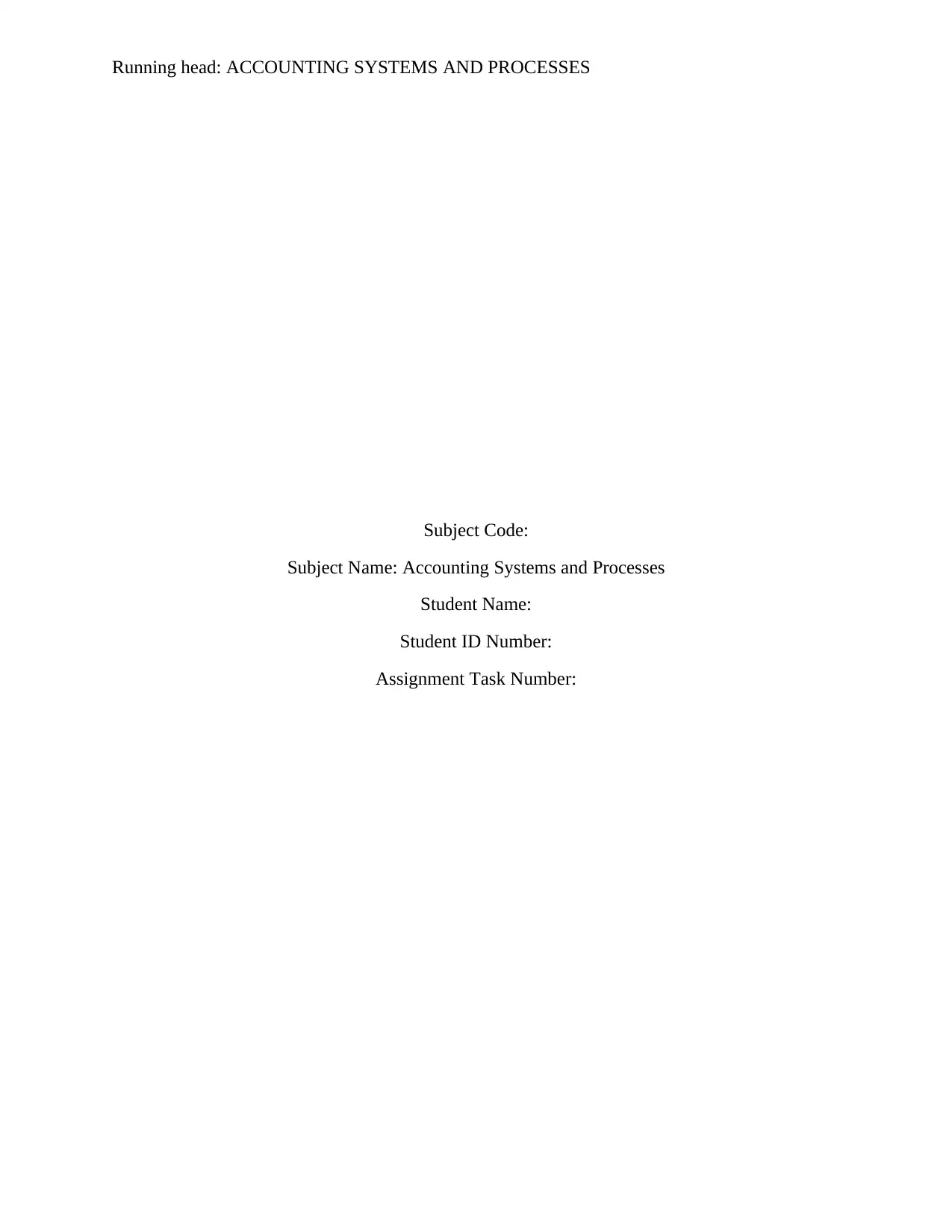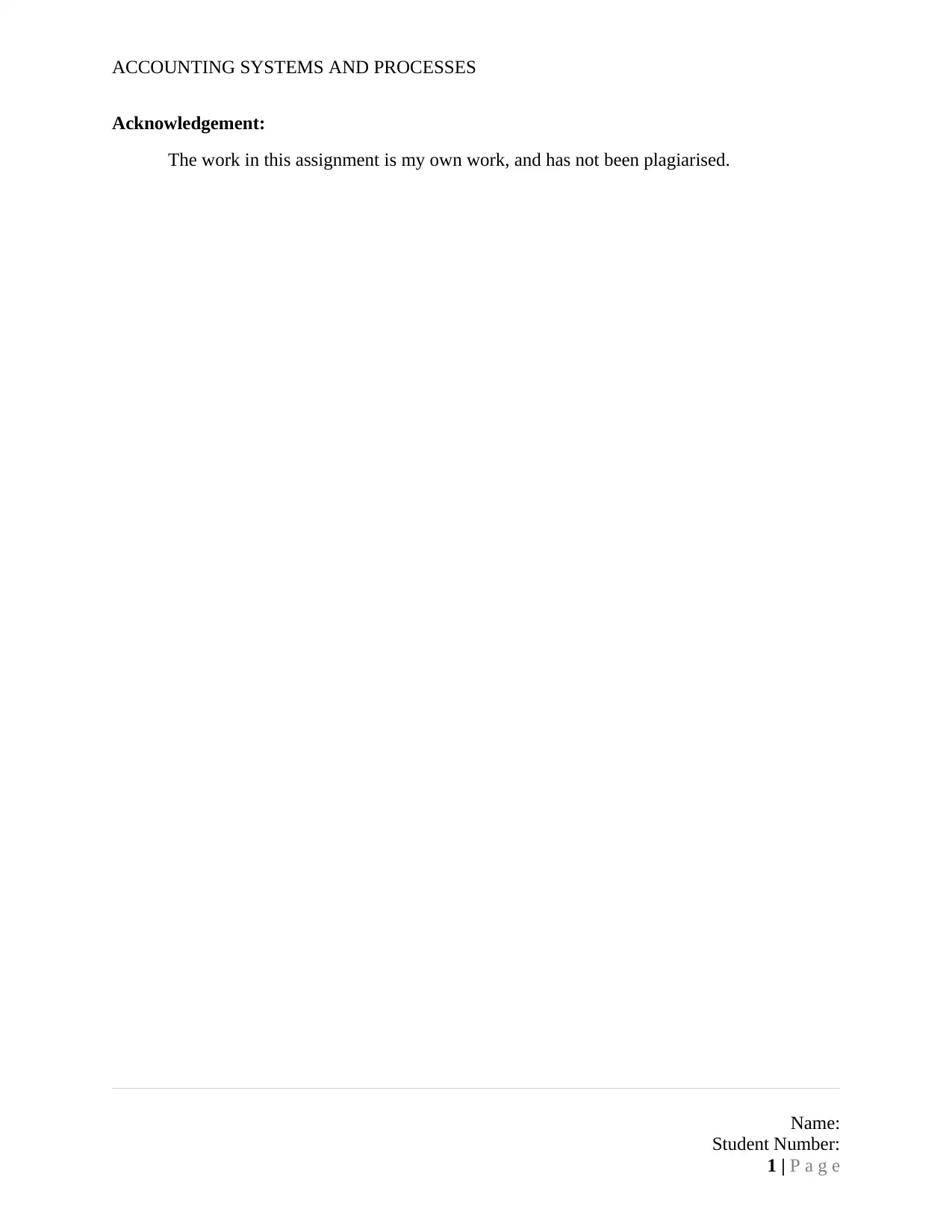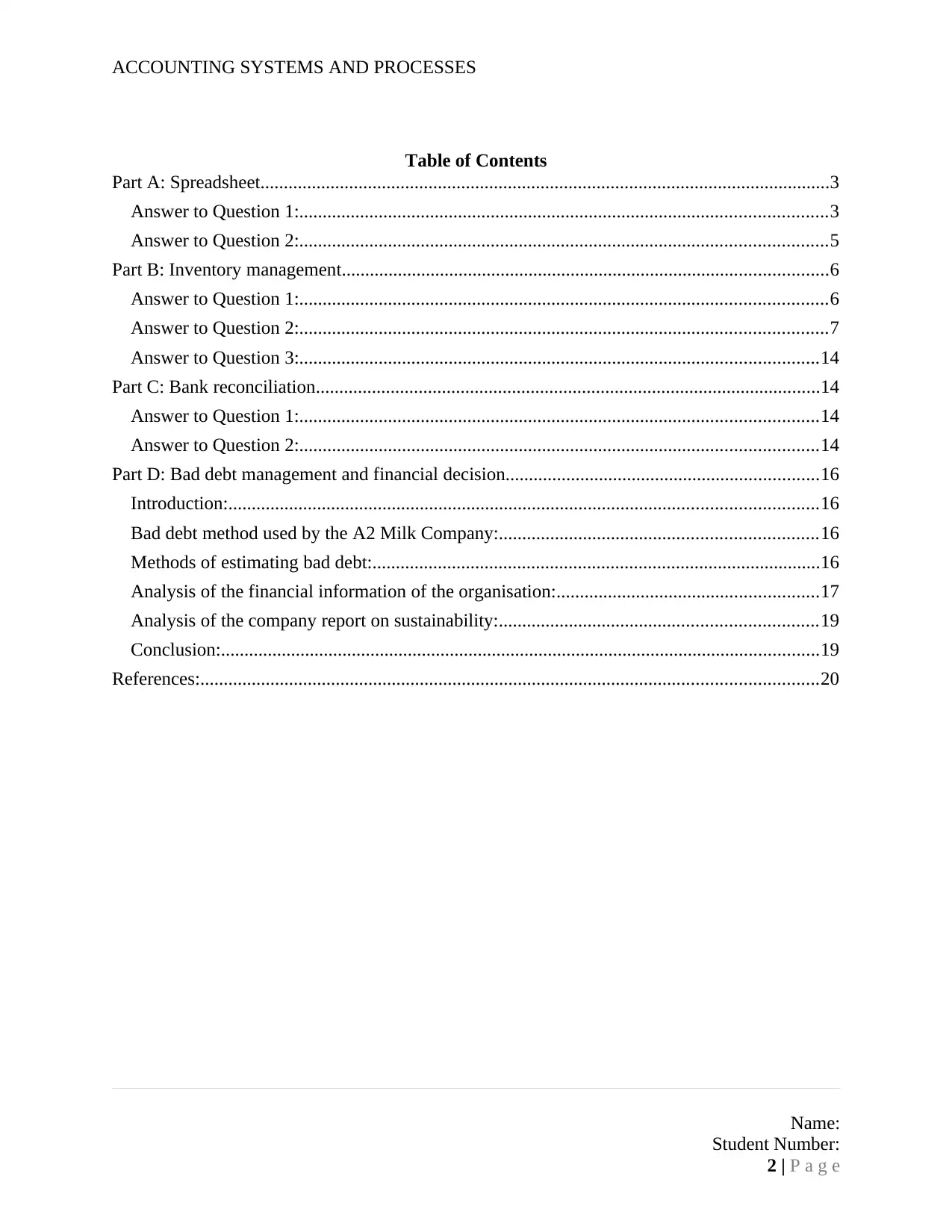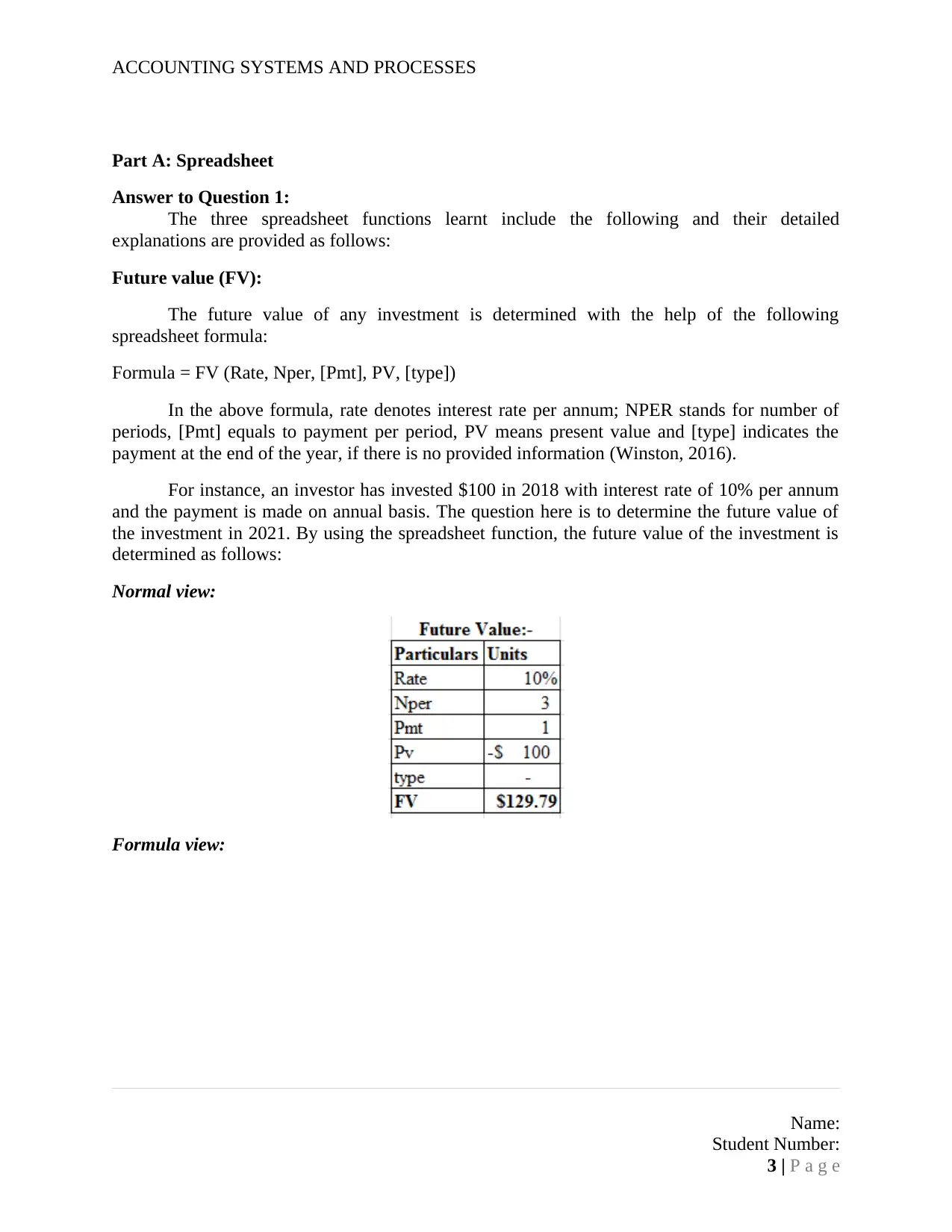Accounting Systems and Processes: Financial Analysis, A2 Milk Company
VerifiedAdded on 2023/04/20
|22
|3384
|234
Report
AI Summary
This report provides a detailed analysis of accounting systems and processes, covering spreadsheet functions, inventory management, bank reconciliation, and bad debt management. It begins with an explanation of spreadsheet functions such as future value (FV), net present value (NPV), and effective interest rate. The report then discusses the differences between periodic and perpetual inventory systems, applying various costing methods like average cost, LIFO, and FIFO to Bike World's inventory. Furthermore, it includes a bank reconciliation statement and journal entries. The final section focuses on bad debt management and financial decisions related to the A2 Milk Company, analyzing its financial performance using ratios like net margin, quick ratio, and debt-to-equity ratio, and evaluating its sustainability performance. The report concludes with a recommendation regarding investment decisions based on these analyses. This student-contributed assignment is available on Desklib, a platform offering study tools and resources for students.

Running head: ACCOUNTING SYSTEMS AND PROCESSES
Subject Code:
Subject Name: Accounting Systems and Processes
Student Name:
Student ID Number:
Assignment Task Number:
Subject Code:
Subject Name: Accounting Systems and Processes
Student Name:
Student ID Number:
Assignment Task Number:
Paraphrase This Document
Need a fresh take? Get an instant paraphrase of this document with our AI Paraphraser

ACCOUNTING SYSTEMS AND PROCESSES
Acknowledgement:
The work in this assignment is my own work, and has not been plagiarised.
Name:
Student Number:
1 | P a g e
Acknowledgement:
The work in this assignment is my own work, and has not been plagiarised.
Name:
Student Number:
1 | P a g e

ACCOUNTING SYSTEMS AND PROCESSES
Table of Contents
Part A: Spreadsheet..........................................................................................................................3
Answer to Question 1:.................................................................................................................3
Answer to Question 2:.................................................................................................................5
Part B: Inventory management........................................................................................................6
Answer to Question 1:.................................................................................................................6
Answer to Question 2:.................................................................................................................7
Answer to Question 3:...............................................................................................................14
Part C: Bank reconciliation............................................................................................................14
Answer to Question 1:...............................................................................................................14
Answer to Question 2:...............................................................................................................14
Part D: Bad debt management and financial decision...................................................................16
Introduction:..............................................................................................................................16
Bad debt method used by the A2 Milk Company:....................................................................16
Methods of estimating bad debt:................................................................................................16
Analysis of the financial information of the organisation:........................................................17
Analysis of the company report on sustainability:....................................................................19
Conclusion:................................................................................................................................19
References:....................................................................................................................................20
Name:
Student Number:
2 | P a g e
Table of Contents
Part A: Spreadsheet..........................................................................................................................3
Answer to Question 1:.................................................................................................................3
Answer to Question 2:.................................................................................................................5
Part B: Inventory management........................................................................................................6
Answer to Question 1:.................................................................................................................6
Answer to Question 2:.................................................................................................................7
Answer to Question 3:...............................................................................................................14
Part C: Bank reconciliation............................................................................................................14
Answer to Question 1:...............................................................................................................14
Answer to Question 2:...............................................................................................................14
Part D: Bad debt management and financial decision...................................................................16
Introduction:..............................................................................................................................16
Bad debt method used by the A2 Milk Company:....................................................................16
Methods of estimating bad debt:................................................................................................16
Analysis of the financial information of the organisation:........................................................17
Analysis of the company report on sustainability:....................................................................19
Conclusion:................................................................................................................................19
References:....................................................................................................................................20
Name:
Student Number:
2 | P a g e
⊘ This is a preview!⊘
Do you want full access?
Subscribe today to unlock all pages.

Trusted by 1+ million students worldwide

ACCOUNTING SYSTEMS AND PROCESSES
Part A: Spreadsheet
Answer to Question 1:
The three spreadsheet functions learnt include the following and their detailed
explanations are provided as follows:
Future value (FV):
The future value of any investment is determined with the help of the following
spreadsheet formula:
Formula = FV (Rate, Nper, [Pmt], PV, [type])
In the above formula, rate denotes interest rate per annum; NPER stands for number of
periods, [Pmt] equals to payment per period, PV means present value and [type] indicates the
payment at the end of the year, if there is no provided information (Winston, 2016).
For instance, an investor has invested $100 in 2018 with interest rate of 10% per annum
and the payment is made on annual basis. The question here is to determine the future value of
the investment in 2021. By using the spreadsheet function, the future value of the investment is
determined as follows:
Normal view:
Formula view:
Name:
Student Number:
3 | P a g e
Part A: Spreadsheet
Answer to Question 1:
The three spreadsheet functions learnt include the following and their detailed
explanations are provided as follows:
Future value (FV):
The future value of any investment is determined with the help of the following
spreadsheet formula:
Formula = FV (Rate, Nper, [Pmt], PV, [type])
In the above formula, rate denotes interest rate per annum; NPER stands for number of
periods, [Pmt] equals to payment per period, PV means present value and [type] indicates the
payment at the end of the year, if there is no provided information (Winston, 2016).
For instance, an investor has invested $100 in 2018 with interest rate of 10% per annum
and the payment is made on annual basis. The question here is to determine the future value of
the investment in 2021. By using the spreadsheet function, the future value of the investment is
determined as follows:
Normal view:
Formula view:
Name:
Student Number:
3 | P a g e
Paraphrase This Document
Need a fresh take? Get an instant paraphrase of this document with our AI Paraphraser

ACCOUNTING SYSTEMS AND PROCESSES
This function is useful, as it assists in finding the future value of a specific investment
having periodic payment and constant rate of interest.
Net present value (NPV):
This function provides the estimated earnings of a project or investment. NPV is
computed with the help of the following formula:
Net Present Value = NPV (rate, value 1, [value 2],…)
The rate denotes the discount rate for a particular period and the values indicate positive
or negative cash flows. The negative values are considered as payments, while positive values
are considered as cash inflows. For instance, an organisation is planning to undertake a project
having an economic life of 5 years with required rate of return of 10%. The cash inflows and
NPV are calculated as follows:
Normal view:
Formula view:
Name:
Student Number:
4 | P a g e
This function is useful, as it assists in finding the future value of a specific investment
having periodic payment and constant rate of interest.
Net present value (NPV):
This function provides the estimated earnings of a project or investment. NPV is
computed with the help of the following formula:
Net Present Value = NPV (rate, value 1, [value 2],…)
The rate denotes the discount rate for a particular period and the values indicate positive
or negative cash flows. The negative values are considered as payments, while positive values
are considered as cash inflows. For instance, an organisation is planning to undertake a project
having an economic life of 5 years with required rate of return of 10%. The cash inflows and
NPV are calculated as follows:
Normal view:
Formula view:
Name:
Student Number:
4 | P a g e

ACCOUNTING SYSTEMS AND PROCESSES
This method is useful, as it is possible to determine the projected earnings of an
investment made in future (Mayes, 2014).
Effect:
In order to calculate the effective annual rate of interest, effect function is used. This
function is used in Excel containing the following formula:
Effective annual interest rate = Effect (Nominal_Rate, NPERY)
In the above formula, nominal_rate denotes the nominal rate of interest and NPER
indicates the number of compounding per annum. For example, a payment needs to be settled
with a nominal rate of interest of 12% and the number of compounding per annum is 12. The
effective annual rate is computed with the help of the following formula in spreadsheet:
Normal view:
Formula view:
Name:
Student Number:
5 | P a g e
This method is useful, as it is possible to determine the projected earnings of an
investment made in future (Mayes, 2014).
Effect:
In order to calculate the effective annual rate of interest, effect function is used. This
function is used in Excel containing the following formula:
Effective annual interest rate = Effect (Nominal_Rate, NPERY)
In the above formula, nominal_rate denotes the nominal rate of interest and NPER
indicates the number of compounding per annum. For example, a payment needs to be settled
with a nominal rate of interest of 12% and the number of compounding per annum is 12. The
effective annual rate is computed with the help of the following formula in spreadsheet:
Normal view:
Formula view:
Name:
Student Number:
5 | P a g e
⊘ This is a preview!⊘
Do you want full access?
Subscribe today to unlock all pages.

Trusted by 1+ million students worldwide

ACCOUNTING SYSTEMS AND PROCESSES
Thus, this function provides slightly higher interest rate in contrast to the rate quoted by
the lender.
Answer to Question 2:
VLOOKUP function, also known as vertical lookup, is an in-built spreadsheet function,
which is designed to work with data organised into columns. For a particular value, this function
finds the value in one data column and it returns the corresponding value from another column
(McFedries, 2016).
Name:
Student Number:
6 | P a g e
Thus, this function provides slightly higher interest rate in contrast to the rate quoted by
the lender.
Answer to Question 2:
VLOOKUP function, also known as vertical lookup, is an in-built spreadsheet function,
which is designed to work with data organised into columns. For a particular value, this function
finds the value in one data column and it returns the corresponding value from another column
(McFedries, 2016).
Name:
Student Number:
6 | P a g e
Paraphrase This Document
Need a fresh take? Get an instant paraphrase of this document with our AI Paraphraser

ACCOUNTING SYSTEMS AND PROCESSES
Part B: Inventory management
Answer to Question 1:
The major points of differences between periodic and perpetual inventory systems are
discussed as follows:
Basis of comparison Perpetual Inventory System Periodic Inventory System
Recording Regular update of inventory
records
Periodical updates of inventory
records
Ascertainment of
closing inventory
It is ascertained based on
inventory records
It is determined based on physical
inventory count
Inventory count Conducted to assure if units held
are in accordance with records
Conducted for ascertaining the cost
of sales
Inventory control Increased level of control, since
the management has knowledge
of the quantity at all times
No control, since the management
has no knowledge of the quantity
until the period end
Temporary accounts No maintenance of temporary
accounts, as there is direct
recording in inventory count
(Chołodowicz & Orłowski, 2015)
There is maintenance of temporary
accounts such as returns, sales and
purchased, which are closed at the
period end
Cost Expensive in terms of
maintenance owing to need of
competent professionals
Less costly to maintain due to
requirement of lower cost and
workforce (Miller-Nobles,
Mattison & Matsumura, 2016)
For instance, in case of Bike World, it could be observed that the organisation has
purchased 20 units of merchandise inventory on 5th June at $217 per unit. The journal entry in
case of perpetual inventory system is represented as follows:
Date Particulars Debit Amount Credit amount
05-Jun Merchandise Inventory Account................................Dr $4,340
To Accounts Payable Account $4,340
By considering the above example, the journal entry in case of periodic inventory system
is depicted as follows:
Date Particulars Debit Amount Credit amount
05-Jun Purchase Account................................Dr $4,340
To Accounts Payable Account $4,340
After considering all the above aspects, it could be said that although it is easy to
implement a periodic inventory system in place, it lacks the additional benefits of a perpetual
Name:
Student Number:
7 | P a g e
Part B: Inventory management
Answer to Question 1:
The major points of differences between periodic and perpetual inventory systems are
discussed as follows:
Basis of comparison Perpetual Inventory System Periodic Inventory System
Recording Regular update of inventory
records
Periodical updates of inventory
records
Ascertainment of
closing inventory
It is ascertained based on
inventory records
It is determined based on physical
inventory count
Inventory count Conducted to assure if units held
are in accordance with records
Conducted for ascertaining the cost
of sales
Inventory control Increased level of control, since
the management has knowledge
of the quantity at all times
No control, since the management
has no knowledge of the quantity
until the period end
Temporary accounts No maintenance of temporary
accounts, as there is direct
recording in inventory count
(Chołodowicz & Orłowski, 2015)
There is maintenance of temporary
accounts such as returns, sales and
purchased, which are closed at the
period end
Cost Expensive in terms of
maintenance owing to need of
competent professionals
Less costly to maintain due to
requirement of lower cost and
workforce (Miller-Nobles,
Mattison & Matsumura, 2016)
For instance, in case of Bike World, it could be observed that the organisation has
purchased 20 units of merchandise inventory on 5th June at $217 per unit. The journal entry in
case of perpetual inventory system is represented as follows:
Date Particulars Debit Amount Credit amount
05-Jun Merchandise Inventory Account................................Dr $4,340
To Accounts Payable Account $4,340
By considering the above example, the journal entry in case of periodic inventory system
is depicted as follows:
Date Particulars Debit Amount Credit amount
05-Jun Purchase Account................................Dr $4,340
To Accounts Payable Account $4,340
After considering all the above aspects, it could be said that although it is easy to
implement a periodic inventory system in place, it lacks the additional benefits of a perpetual
Name:
Student Number:
7 | P a g e

ACCOUNTING SYSTEMS AND PROCESSES
inventory system like real time insight on profitability and margins. Thus, perpetual inventory
system would be beneficial for Bike World.
Answer to Question 2:
Perpetual inventory system:
Average cost method (Normal view):
Average cost method (Formula view):
Name:
Student Number:
8 | P a g e
inventory system like real time insight on profitability and margins. Thus, perpetual inventory
system would be beneficial for Bike World.
Answer to Question 2:
Perpetual inventory system:
Average cost method (Normal view):
Average cost method (Formula view):
Name:
Student Number:
8 | P a g e
⊘ This is a preview!⊘
Do you want full access?
Subscribe today to unlock all pages.

Trusted by 1+ million students worldwide

ACCOUNTING SYSTEMS AND PROCESSES
LIFO method (Normal view):
LIFO method (Formula view):
Name:
Student Number:
9 | P a g e
LIFO method (Normal view):
LIFO method (Formula view):
Name:
Student Number:
9 | P a g e
Paraphrase This Document
Need a fresh take? Get an instant paraphrase of this document with our AI Paraphraser

ACCOUNTING SYSTEMS AND PROCESSES
FIFO method (Normal view):
FIFO method (Formula view):
Name:
Student Number:
10 | P a g e
FIFO method (Normal view):
FIFO method (Formula view):
Name:
Student Number:
10 | P a g e

ACCOUNTING SYSTEMS AND PROCESSES
Periodic inventory system:
Average cost method (Normal view):
Average cost method (Formula view):
Name:
Student Number:
11 | P a g e
Periodic inventory system:
Average cost method (Normal view):
Average cost method (Formula view):
Name:
Student Number:
11 | P a g e
⊘ This is a preview!⊘
Do you want full access?
Subscribe today to unlock all pages.

Trusted by 1+ million students worldwide
1 out of 22
Related Documents
Your All-in-One AI-Powered Toolkit for Academic Success.
+13062052269
info@desklib.com
Available 24*7 on WhatsApp / Email
![[object Object]](/_next/static/media/star-bottom.7253800d.svg)
Unlock your academic potential
Copyright © 2020–2025 A2Z Services. All Rights Reserved. Developed and managed by ZUCOL.





